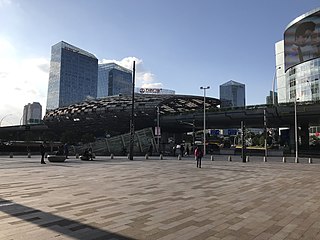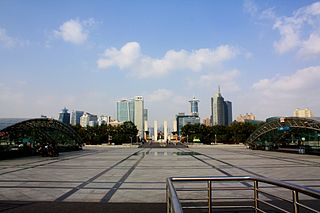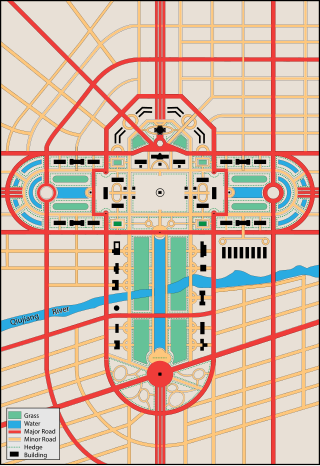
Shanghai is a direct-administered municipality and the most populous urban area in China. The city is located on the Chinese shoreline on the southern estuary of the Yangtze River, with the Huangpu River flowing through it.

Pudong is a district of Shanghai located east of the Huangpu, the river which flows through central Shanghai. The name Pudong was originally applied to the Huangpu's east bank, directly across from the west bank or Puxi, the historic city center. It now refers to the broader Pudong New Area, a state-level new area which extends all the way to the East China Sea.

The Oriental Pearl Tower is a Futurist TV tower in Lujiazui, Shanghai. Built from 1991 to 1994, the tower was the tallest structure in China until the completion of nearby World Financial Center in 2007. Shanghai's first AAAAA tourist attraction, The tower's unique architecture, height, and fifteen observation decks have made it a cultural icon of the city.

The Shanghai Museum is a municipal public museum of ancient Chinese art, situated on the People's Square in the Huangpu District of Shanghai, China. It is funded by the Shanghai Municipal Culture and Tourism Bureau.

Yangpu is one of the 16 districts of Shanghai. It is located in the northeastern part of downtown Shanghai, bordering the Huangpu River on the east and south, Hongkou on the west, and Baoshan on the north. The southern part of Yangpu District is 4 km (2.5 mi) away from The Bund, a major tourist attraction. It is predominantly composed of residential communities, with a total area of 60.61 km2 (23.40 sq mi) and a population of 1,242,548 as of 2020. The district administers 12 subdistricts.
The China Academy of Art is one of the most prestigious top colleges of fine arts in China, and is the first national comprehensive institution of higher art education in modern China. It is recognized as the country's First-Class Discipline Construction University.

Shanghai Science and Technology Museum is a station on Shanghai Metro Line 2. It features the large underground AP Plaza shopping mall.

Line 13 is a north-west to south-east line of the Shanghai Metro network. It runs between Jinyun Road in Jiading and Zhangjiang Road in Pudong. It was once used as a dedicated line for the World Expo to serve the 2010 Shanghai World Expo. The line is colored pink on system maps.
The Silk Route Museum is located in Jiuquan, Gansu Province along the Silk Road, a trading route connecting Rome to China, used by Marco Polo. It is also built over the tomb of the Xiliang King in Gansu Province. Founded by Mei Ping Wu and staffed by volunteers, the museum is dedicated to the fostering of an enhanced understanding between East and West.

China Art Museum, Shanghai is a municipal art museum of Shanghai City. It is a public welfare institution funded by the Shanghai City Culture and Tourism Bureau.

The Power Station of Art is a municipal contemporary art museum in Huangpu, Shanghai, China. The museum is a public institution funded by the Shanghai City Culture and Tourism Bureau.

Former Residence of Mao Zedong or Mao Zedong's Former Residence was built in the late Qing dynasty (1644–1911). It is located in Shaoshan Village of Shaoshan Township in Shaoshan, Xiangtan, Hunan, China. The building was the birthplace and childhood home of Mao Zedong, the first leader of the People's Republic of China. It has a building area of about 472.92-square-metre (5,090.5 sq ft), embodies buildings such as the old houses, the Mao Zedong Memorial Hall, the Bronze Statue of Mao Zedong, the Cultural relics Exhibition Hall, and the Dishui Hole.

The Shanghai Japanese School (SJS) is a Japanese international school serving primary and junior high school levels in Shanghai. It has two campuses, one in Hongqiao and one in Pudong. The school's teachers are Japanese citizens. The school also has a senior high school component.

The Greater Shanghai Plan was a 1927 plan for the city of Shanghai, China, drawn up by the Nationalist Government of the Republic of China in Nanjing. It was presented at the 123rd meeting of the Shanghai City Government in July 1929 and as one of its provisions allocated 7,000 mu in the modern day Jiangwan Subdistrict of Shanghai's Yangpu District for the construction of a government headquarters and administration centre. Had it been completed, the government headquarters building would have stood close to the junction of today's Hengren Road (恒仁路) and the Qingyuan Ring Road (清源环路).

Shanghai Natural History Museum is a station on the Shanghai Metro, which services Line 13 and opened on December 19, 2015. The station is located near the Shanghai Natural History Museum.

The Changsha Jiandu Museum is a history museum located at No. 92 of Baisha Road in Tianxin District, Changsha, Hunan, China. It is adjacent to Baisha Well in the south and Tianxin Pavilion in the west. Changsha Jiandu Museum is currently a large-scale modern themed museum dedicated to the collection, preservation, arrangement, study, and exhibition of bamboo and wooden slips (Jiandu). It covers an area of 14,100-square-metre (152,000 sq ft).

The Changsha Museum is a history museum located at Beichen Delta in Kaifu District, Changsha, Hunan, China. It is adjacent to the Changsha Concert Hall, Changsha Planning Exhibition Hall and Changsha Library. It has a constructed area of 24,000 square metres (260,000 sq ft).

Wenzhou Museum is a museum run by the city of Wenzhou, located on Shifu Road, Lucheng District.
Lhasa Mass Culture and Sports Center, located in Liwu New District, Lhasa, Tibet Autonomous Region, is a comprehensive venue integrating stadium, gymnasium and Tibet Yak Museum, and is also the highest elevation modern stadium in the world.

















